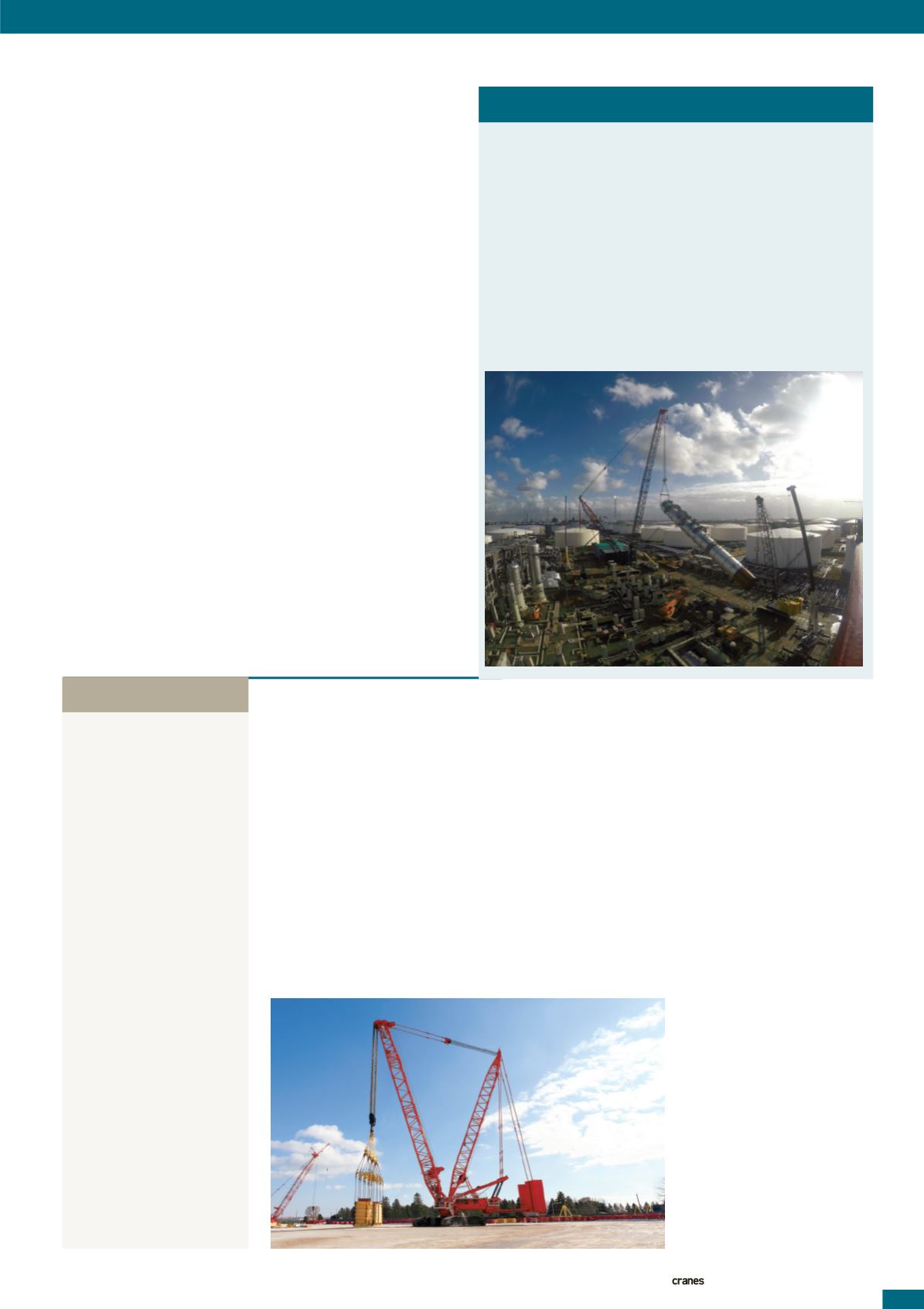
INTERNATIONAL
ANDSPECIALIZED TRANSPORT
■
APRIL 2015
WORLDNEWS
11
Barloworld launches
SAcranedivision
A cranedivisionhas been
added toBarloworld
Transport, extending the
company’s range of transport,
lifting andhandling services
inSouthAfrica. Barloworld
Transport is part of Barloworld
LogisticsGroup.
BarloworldCraneswill be
runbyReboneMotsatsiwho
has been appointedmanaging
director and IanGerrard
will be operations director.
Motsatsi is an industrial
engineering graduatewith
logistics industry experience.
At BarloworldLogistics he
was business development
head:mining& construction.
Gerrardhasmore than40
years of experience and is an
expert in crane, rigging, heavy
lifting andheavy transport
projects, Barloworld said.
The fleet includes seven
Liebherr all terrain cranes
between40 and200 tonnes
capacity and sixTadano truck
mounted cranes from34 to
60 tonnes. The cranedepot
will be in Isando, Kempton
Park. Additional services
offered include rigging
engineering, CAD job
planning, integratedproject
solutions, site inspections,
risk assessments and
projectmanagement.
Commentingon the
newdivision, SteveFord,
BarloworldLogistics chief
executive, said, “Barloworld
Cranes represents another step
inour journeyof investing in
nicheproducts and services
enablingus tooffer our clients
moreholistic supply chain
solutions. It is anatural fit
toour business, specifically
for clients needing tomove
abnormal cargoor engaging in
specializedprojects.”
Lifting service provider AertssenKranen and international heavy lift
and specialized transport specialist ALEhave finished installing the
main fractionators at theOptara project inAntwerp, Belgium.
TheOptara project forms part of a €1 billion (US$ 1.1 billion)
investment from Total at the refining and petrochemical complex in
Antwerp. Work at the sitewill include the construction of a newunit
and the conversion of an existingunit, a spokesperson said.
Themain fractionatorsweighed250 tonnes andmeasured 57
metres long and had a diameter of 10m. It wasmoved to position
using 32 axle lines of self propelledmodular transporter (SPMT).
Once inposition, a 650 tonne capacity TerexSuperlift 3800 crawler
cranewas used to lift and install the fractionators. A280 tonneHitachi
SCX2800-2 crawler cranewas used as a tailing crane.
MILESTONEREACHED INOPTARAPROJECT
ManitowoccompletesMLC650
crawlercraneVPC-Max testing
Manitowochas completed
load testingof itsManitowoc
MLC650 lattice boom crawler
cranewith the variable
position counterweight (VPC)
Max attachment.
TheVPC-Max attachment
raises the capacityof the
MLC650 to700 tonnes.
It includes additional
counterweight and a beam
that automatically extends
the counterweight basedon
the load.
In addition, theVPC-Max
attachment requires fewer
components and assembly
steps, themanufacturer said.
For the load test, the crane
was positioned to apply the
maximum stresses through
the structure, including the
For theVPC-Max
load test, the crane
waspositioned to
apply themaximum
stresses through
the structure
boompositionedover the
corner of the crawler crane.
DustinSoerens,Manitowoc
marketingmanager for lattice
boom cranes, explained, “We
attachedhundreds of strain
gauges to theMLC650 and
picked anumber of loads
in the test yard to test its
capacitywith theVPC-Max
attachment.
“The testingwent very
wellwithno surprises.No
changes areneededon
the crane, as it performed
superbly.We’rewell on
ourway to releasing this
innovative crane to the
globalmarket. The successful
testingwas agreatmoment
for everyone atManitowoc,”
Soerens commented. “We’re
workingveryhard to release
a crane thatwill define the
next generationof lifting
equipment.”
HIGHLIGHTS
■
The Lifting Equipment
Engineers Association (LEEA)
has released a statement
for UK employers regarding
their obligation to undertake
periodic thorough examination
of all lifting equipment.
LiftingOperations and Lifting
Equipment Regulations
(LOLER), companies are
required to conduct thorough
and frequent examinations
of lifting equipment. The
advice comes after LEEA
wasmade aware that some
users of lifting equipment
are being incorrectly
advised to extend all the
intervals between thorough
examinations to 12months.
Thorough examinations are
usually conducted by external
companies and LEEA is keen
to stress that responsibility
for compliancewith LOLER
lieswith the owner of the
equipment, not suppliers
of examination and
inspection services.


